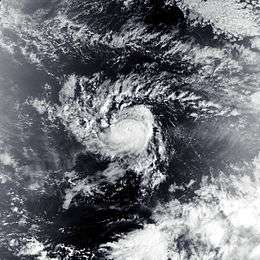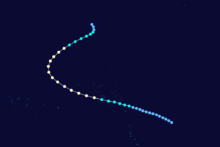Tropical Storm Zelda (1991)
| Severe tropical storm (JMA scale) | |
|---|---|
| Category 1 (Saffir–Simpson scale) | |
 Zelda on November 29, 1991 | |
| Formed | November 27, 1991 |
| Dissipated | December 7, 1991 |
| Highest winds |
10-minute sustained: 110 km/h (70 mph) 1-minute sustained: 150 km/h (90 mph) |
| Lowest pressure | 975 hPa (mbar); 28.79 inHg |
| Fatalities | None |
| Areas affected | Marshall Islands |
| Part of the 1991 Pacific typhoon season | |
Severe Tropical Storm Zelda was the last storm of the 1991 Pacific typhoon season. A disturbance formed near the International Date Line, and strengthened into a tropical depression on November 27. The Joint Typhoon Warning Center (JTWC) reported that the depression had reached tropical storm intensity, thus naming it Zelda. The storm quickly strengthened into a Category 1 typhoon on the Saffir–Simpson hurricane wind scale near the Marshall Islands on November 29. It reached peak of 110 km/h (70 mph), with a barometric pressure of 975 mbar (28.8 inHg). The tropical storm traveled northwestward, and later northeastward. Zelda soon weakened into a tropical storm, and then a tropical depression. The JTWC discontinued warnings on December 4, while the Japanese Meteorological Agency (JMA) continued to track the storm until it crossed the International Date Line again on December 7.
Zelda caused significant damage to the Marshall Islands. Operations at Kwajalein Missile Range were disrupted severely. About 60 percent of homes were destroyed in Ebeye, leaving 6,000 people without residence. Nearly all crops on the islands were destroyed, and food and other supplies were contaminated by salt. No deaths or injuries were reported. Later in December, President George H. W. Bush declared the storm to be a major disaster, allowing the Federal Emergency Management Agency (FEMA) to assist. The Marshall Islands also requested funds from other countries.
Meteorological history

In late November, a circulation was generated near the International Date Line by westerly winds. It was included in the Significant Tropical Weather Advisory at 0600 UTC on November 25. Vertical wind shear prevented strengthening at first, but the disturbance later continued to develop. A tropical cyclone formation alert soon followed from the JTWC.[1] JMA started tracking the disturbance at 0600 UTC on November 27,[2][nb 1] and JTWC issued their first warning 18 hours later on the depression, naming it 31W. The depression quickly intensified, and it became a tropical storm at 0000 UTC on November 28 for JTWC, with winds of 65 km/h (40 mph).[nb 2] Operationally, the storm was upgraded twenty-four hours later, after Kwajalein received stronger winds than expected.[1] JMA upgraded the storm at 0300 UTC on November 29.[2] The tropical storm received the name Zelda.[1] JMA upgraded Zelda to a severe tropical storm eighteen hours later.[2] Zelda rapidly intensified into a Category 1 typhoon on the Saffir–Simpson hurricane wind scale at 1200 UTC of November 29, with winds of 120 km/h (75 mph), near the Marshall Islands.[1] At that time, JMA kept it as a tropical storm with winds of 80 km/h (50 mph), with a pressure reading of 990 mbar (29 inHg).[2]
JMA estimated Zelda has reached peak around 0600 UTC on November 30 at 110 km/h (70 mph), with a barometric pressure of 975 mbar (28.8 inHg).[2] Six hours later, JTWC reported the storm has reached the peak of 145 km/h (90 mph), west of Enewetak. Later, a trough created by Typhoon Yuri caused the subtropical ridge to weaken, allowing Zelda to move northward.[1] By December 1, the storm began to weaken and turned northeast. On December 2, JMA reported the storm had weaken to 100 km/h (60 mph),[2] and JTWC weakened it to 130 km/h (80 mph). The storm weakened below Category 1 typhoon strength on 1800 UTC of the same day, with winds of 110 km/h (70 mph).[5] Upper-level winds soon increased, and Zelda's central convection became sheared.[1] JMA downgraded Zelda to a tropical storm on December 3, and to a tropical depression later that day.[2] A few hours later, JTWC downgraded the storm to a tropical depression, as it turned slightly northwestward, something they did not expect.[5] The circulation detached from the frontal cloud line, and JTWC issued the last warning of the year.[1] The depression turned back northeastward, and JMA stopped tracking just past the International Date Line on December 7.[2][6]
Impact and aftermath
The storm affected Marshall Islands around November 28, producing winds as high as 160 km/h (100 mph). The storm impacted islands of Kwajalein, Majuro, Lae, Wotho, and Eniwetok.[7] Kwajalein Missile Range caught stronger winds than expected from the storm, and operations in the missile range were affected severely.[1] Zelda also produced a pressure of 990.1 hPa (29.24 inHg), which was the lowest pressure ever recorded on Kwajalein.[8] Later, In Ebeye, 60 percent of homes were destroyed, and 6,000 people were left homeless. Food and water supplies were contaminated from salt in surge waves, and the water desalination plant became inoperable.[7] Fresh water production records since 1989 were lost during the storm.[9] The local hospital was still intact, but a few power lines were cut. There were no deaths or significant injuries. Other islands in the nation had their water contaminated by saltwater, and 95 percent of the crops were destroyed by the storm surge.[7] Coral reefs were also damaged when the storm came nearby.[10]
The U.S. Army engaged in cleanup and repairing in the country. On December 6, the 834th Airlift Division sent six C-130s to Kwajalein with supplies.[11] On the same day, President George H. W. Bush declared a major disaster,[12] allowing federal funding to be sent to Arno, Aur, Kwajalein, Lae, Lib, Namu and Ujae islands.[13][14] Despite already getting funding from the United States, Marshall Islands requested for aid via United Nations Disaster Relief Organization (UNDRO) on December 18.[7]
By March 26, 1992, about $98,000 (1991 USD) worth of relief goods were sent to the Marshall Islands, from UNDRO, United Nations Development Programme (UNDP), and Australia. FEMA sent $1.518 million (1991 USD) to affected families.[7]
Notes
- ↑ The Japan Meteorological Agency is the official Regional Specialized Meteorological Center for the western Pacific Ocean.[3]
- ↑ Wind estimates from the JMA and most other basins throughout the world are sustained over 10 minutes, while estimates from the United States-based Joint Typhoon Warning Center are sustained over 1 minute. 10 minute winds are about 1.14 times the amount of 1 minute winds.[4]
References
- 1 2 3 4 5 6 7 8 Mundell, Dan B.; Wells, Frank H.; McDonald, Brian L.; Delanuez, Carlos A.; Belew, Ray O. 1991 Annual Tropical Cyclone Report (PDF) (Report). Joint Typhoon Warning Center. pp. 154–157. Retrieved May 18, 2014.
- 1 2 3 4 5 6 7 8 "RSMC Best Track Data (Text)". Japan Meteorological Agency. 1990–1999. Retrieved May 28, 2014.
- ↑ Annual Report on Activities of the RSMC Tokyo – Typhoon Center 2000 (PDF) (Report). Japan Meteorological Agency. February 2001. p. 3. Retrieved June 1, 2014.
- ↑ Landsea, Chris (April 21, 2006). "Subject: D4) What does "maximum sustained wind" mean? How does it relate to gusts in tropical cyclones?". Frequently Asked Questions:. National Oceanic and Atmospheric Administration's Atlantic Oceanographic and Meteorological Laboratory. Retrieved May 29, 2014.
- 1 2 "Typhoon Zelda (31W) Best Track". Joint Typhoon Warning Center. Retrieved May 31, 2014.
- ↑ Knapp, Kenneth R.; Kruk, Michael C.; Levinson, David H.; Diamond, Howard J.; Neumann, Charles J. (2010). 1991 ZELDA (1991329N04181). The International Best Track Archive for Climate Stewardship (IBTrACS): Unifying tropical cyclone best track data (Report). Bulletin of the American Meteorological Society. Retrieved May 31, 2014.
- 1 2 3 4 5 United Nations Disaster Relief Organisation (December 6, 1991). Marshall Islands - Typhoon Zelda Dec 1991 UNDRO Situation Reports 1-3 (Report). ReliefWeb. Retrieved January 8, 2014.
- ↑ "Pacific ENSO Update: 2nd Quarter 2015" (PDF). 21 (2). United States Pacific El Niño-Southern Oscillation (ENSO) Applications Climate Center. May 29, 2015. Archived from the original on March 19, 2016.
- ↑ Republic of Marshall Islands Statistical Abstract (PDF) (Report). Office of Planning and Statistics. January 18, 1993. p. 201. Retrieved May 27, 2015.
- ↑ Coral Reef Informational System. Status of the Coral Reefs in the Pacific Freely Associated States (PDF) (Report). National Oceanic and Atmospheric Administration. p. 5. Retrieved May 24, 2014.
- ↑ Fredriksen, John C. (2011). The United States Air Force: a chronology. Santa Barbara, Calif.: ABC-CLIO. p. 294. ISBN 1598846825.
- ↑ Associated Press (December 9, 1991). "Declaration Allows Typhoon Disaster Assistance". Retrieved May 24, 2014.
- ↑ "Republic of the Marshall Islands Typhoon Zelda (DR-925)". Federal Emergency Management Agency. Retrieved May 26, 2014.
- ↑ "Designated Areas: Republic of Marshall Islands Typhoon Zelda". Federal Emergency Management Agency. Retrieved May 26, 2014.